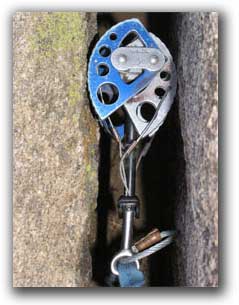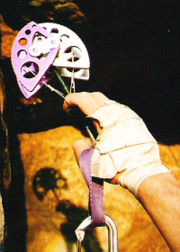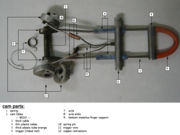Active climbing cam
From DDL Wiki
Contents |
Executive Summary
...
Product Overview
The climbing cam is a rock climbing protection equipment. The main purpose of the camming device is to protect the climber from falling.
Product Requirements
The primary product requirement is that it functions reliably during frequent and varied use. Failure during use of a climbing apparatus can result in death or serious injury. In order for the product to be useful in the mountains it must withstand the abuse of the harsh, exposed environment along with the impacts of frequent use. The climbing cam must function properly each time it is placed to protect against a fall. Furthermore, the cam must function to some extent even when placements are not completely ideal. The size, orientation, or shape of a fissure in the rock may not hold the cam in the ideal position, yet the product must still perform outside the bounds of its ideal use. The most salient concern for this product is that the device functions properly to mitigate the inherent dangers in climbing. A more inclusive inventory of product requirements is listed below:
• Reliable functioning in a fall
• Able to withstand the impacts of climbing
• Functions in diverse placements
• Durable and long lasting
• Easy to identify wear or deterioration
Customer Needs
Beyond the performance requirements of the product, the customer also has specialized needs in order for the product to be useful. The customer’s main concern is that the product enhances the climbing experience through safety, allowing people to travel beyond pervious limits. Climbing is typically pursued for sport or leisure, thus the primary goal may be personal enjoyment. The customer needs a product that's benefits outweigh its detractions. In order for the product to enhance the climbing experience it must be easy and efficient to use, and low in weight as not to impede progress. The customer must be able to quickly and easily place and remove the product from the rock. Often times a more experienced climber will place the gear into the rock while a less experienced climber must be able to remove it. In order for the product to enhance the experience it must be of minimal weight. An overly heavy device may impede and slow a climber to the point of it actually putting the climber in danger. The customer needs of this product rely on an increase in safety without seriously slowing a climber’s movement. A more inclusive inventory of customer needs is listed below:
• Low weight
• Quick and easy placement and removal
• Accommodates removal by less skilled climbers
• Easy to handle between harness and rock
• Fast differentiation between sizes
• Compatible with sizes of older models and other types of climbing protection
• Accommodates a variety of hand sizes
Functionality
On its initial position, the camming device starts with the three lobes aligned horizontally. The trigger is pulled towards the sling using the index and middle finger. This movement slides the trigger down pulling the trigger wires, which are attached to the trigger on one end, and to the lobes on the other end. The tension on the cables causes the lobes to rotate around the axle; the trigger must be pulled until the lobes are completely aligned vertically. During the triggering process, the springs come into action, creating an opposite force that causes the lobes to resist to rotation (and at the same time trying to bring the lobes back to their initial position); the fingers in the trigger must therefore apply resistance to keep the lobes aligned vertically. At this time is when the cam is inserted in the crack. Once the cam is in place, the trigger must be released, causing the lobes to return to their normal position. Now, the springs are in charge of pushing the lobes against the rock walls inside the crack.
Watch a demonstration video on using a climbing cam that we did in the lab.
Analysis of components
Manufacture of parts
The climbing cam is a mechanical device composed of 12 different parts.
Assembly Procedure
The climbing cam seems to have been assembled roughly using the following process. Most of the parts used in this assembly do not have any external fasteners/screws; this reduces the assembly time considerably. Some parts however require welding to be secured which will increase assembly time. Finally there are many very small parts which would produce handling difficulties during orientation and insertion.
A. Initial Base Assembly
1. Taking the thick cable (3) and inserting it into the thick plastic orange tube (5).
2. Bending the thick cable to form a ‘U’ shape.
3. The bent thick cable seems to have been inserted into the finger support (9) and then fused in place.
4. Two thin plastic tubes (4) were then inserted over the open side of the assembly.
B. Trigger Assembly
1. The three trigger wires (11) were connected and fused into the trigger (6).
2. Then the wires attaching the cam lobes (2) to the trigger assembly are joined and fused using the three copper connectors (12).
3. Spring pins (10) are then inserted into the three cam lobes.
C. Final Assembly
1. The initial base assembly is then inserted through the trigger base assembly.
2. Then the cam lobes along with the two springs (1) are aligned on the axle.
3. Axle ends (8) are then fused onto the initial base assembly.
4. Finally the axle is put through the axle ends and welded shut.
* Note: numbers in parentheses correspond to part number
Failure analysis
The climbing cam relies mostly on the correct functionality of the lobes, which are the parts in contact with the rock while the device is in place. The lobes rest on the axle and the springs give them the force keeping them against the rock walls. The camming device's main cable is also crucial, since it is attached to the axle and it is the part holding the weight.
Additionally, during climbing more than one cam is used. In case of any single one cam failing, the remaining cams will support the climber(s) from falling.
DFMA, FMEA and DFE Analysis
The design for manufacture-assembly (DFMA) and the environment (DFE) as well as a failure mode and effects analysis (FMEA) were performed for each individual component of the mechanism. The outcomes are arranged as follows:
| Part number | Parts | DFMA | DFE |
|---|---|---|---|
| 1 | spring | attaching the spring onto the axle is no problem as there is only one way it can go on, attaching the springs to the pins are complicated due to their very small size | spring may be made leaner, metal can be recycled |
| 2 | cam lobes | Due to the partial symmetry of the cam lobes, orientation time during assembly is reduced | casting instead of machining to reduce waste metal, recycle metal |
| 3 | main cable | Fully symmetrical and large enough to manipulate it easily with bare hands | increase durability to maximize first life, recycle material |
| 4 | thin plastic tubes | Designed for easy alignment as they both have axial symmetry | make plastic tube shorter, recycle plastic |
| 5 | sling; plastic tube (orange) | Similar to the thin plastic tubes this tube has axial symmetry and thus orientation time during assembly is minimized | less thick plastic, recycle plastic |
| 6 | trigger | The trigger can be inserted both directions i.e. it only has one axis which it must be rotated upon insertion | use less material, recycle material |
| 7 | axle | The axle is made of extremely durable metal and is a simple cylinder construction which is easy to handle. Additionally the parts which have to be inserted on the axle can be done so easily as there is very little resistance to insertion | use material efficiently, casting instead of machining, recycle metal |
| 8 | axle ends | The ends have to be oriented over two axes upon insertion which increased the time of assembly this can be eliminated by making it symmetrical over one face | use less material to weld, use a lower emission production like join/bend |
| 9 | finger support | Simple part which only requires two forms of alignment on insertion, also it is large enough to handle with the hands easily | reduce mass, casting instead of machining the holes, recycle material |
| 10 | spring pin | the spring pins are symmetrical over one axis but they are extremely small and insertion into the cam lobes would require extra time | use less metal, recycle material |
| 11 | trigger wire | The wire is simple and large enough to install without the aid of other tools | increase durability to maximize first life, recycle material |
| 12 | copper connector | The copper connectors again are extremely small but they are symmetrical over two axes thus orientation is not a problem with them, insertion and securing though will take additional time as it needs to be welded | use lighter material, recycle less material |
| Part number | Parts | DFE | S | O | D | RPN |
|---|---|---|---|---|---|---|
| 1 | spring | failure of all 3 springs would result in complete failure of the cam in normal usage. cam could still be partially functional with one or two failed springs but should not be used for climbing. cam could still function as passive protection without springs. | ||||
| 2 | cam lobes | failure of one cam lobe by serious deformation would reduce the friction provided by the cam it would also interfere with how the other lobes engaged within the rock. | ||||
| 3 | main cable | a severed cable would result in the cam no longer supporting the weight of a falling climber. excessively worn or severely bent cables should be used with extreme caution. | ||||
| 4 | thin plastic tubes | failure of tubing would accelerate the deterioration of the main cable, thus reducing the lifespan of the product. Failure would also increase force needed to retract trigger. | ||||
| 5 | sling; plastic tube (orange) | Failure of tubing would result in faster wearing of main cable and also wearing on nylon slings often looped onto cam and clipped to rope. | ||||
| 6 | trigger | Failure of trigger would release trigger cables and make placement and retrieval of cam very difficult yet still possible | ||||
| 7 | axle | Failure of axle by complete fracture would result in a complete failure of the cam yielding it unsafe for use in climbing | ||||
| 8 | axle ends | failure of axle ends would result in a detachment of the axle from the main cable. If both ends were to fail the cam would not support the weight of a falling climber. Failure of one end would result in an unbalanced force on the cam and the lobes would probably be spun free form the rock | ||||
| 9 | finger support | Complete fracture of finger support would make retrieval and placement of cam difficult but still safe for climbing | ||||
| 10 | spring pin | failure of a spring pin would have the same effects as failure of the spring | ||||
| 11 | trigger wire | failure of all trigger wires would make placement and retrieval of cam extremely difficult, if not impossible in normal climbing situations. Partial failure of wires would make placement and retrieval difficult. | ||||
| 12 | copper connector | Failure of the connectors would be very similar to failure of the trigger wires, making it difficult to place and remove the product |








